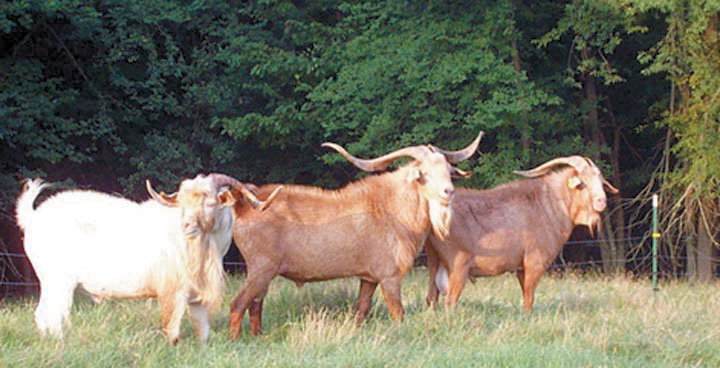In the diverse and competitive world of goat farming, one breed continues to distinguish itself as a champion of resilience and meat production: the Kiko goat. Originating in the rugged highlands of New Zealand, this hardy breed has found a stronghold in the United States. It is now poised to make a significant impact on international markets. With their adaptability, high-quality meat production, and minimal input requirements, Kiko goats represent the future of sustainable small ruminant farming.

The Maori Roots of the Kiko Goat
The Kiko goat’s name reflects its purpose. Derived from the Maori word for “flesh” or “meat,” the breed was developed in New Zealand through the efforts of the Goatex Group LLC in the 1980s. The program utilized feral females known for their survivability and crossbred them with dairy bucks, including Nubians, Toggenburgs, and Saanens. The result? A goat with unparalleled meat production abilities and resilience under minimal input conditions.
These goats thrived in the harsh, untamed landscapes of New Zealand, where they demonstrated their adaptability to a variety of climates and terrains. This practicality-focused breeding process ensured the Kiko’s reputation as a meat goat capable of excelling in environments ranging from temperate to semi-arid regions.
Breed Characteristics
Kiko goats are a medium to large breed designed for efficient and economical meat production. They exhibit several characteristics that make them stand out among other meat goat breeds:
Size: Females typically weigh between 100 and 180 pounds, while bucks range from 200 to 250 pounds.
Color Variations: Though many North American Kikos are white (due to the dominant white gene in the imported population), the breed displays various colors, including cream, black, and mixed patterns.
Horns: Both males and females have horns, with bucks sporting long, twisted horns ideal for self-defense and thermoregulation.
Hardiness: Kikos are known for their exceptional ability to thrive under natural conditions, achieving substantial weight gains without supplemental feeding.
Maternal Traits: Kiko females are renowned for their excellent udder placement, attachment, and ability to raise multiple offspring without intervention, even in less-than-ideal conditions.
Kiko goats are also exceptional browsers, capable of thriving on diverse forage and contributing to land management by controlling brush and weeds. This ability makes them a productive livestock choice and a valuable tool for sustainable farming practices.
Why Kiko Goats Excel in Meat Production
The Kiko’s success in meat production is rooted in its growth rate and efficiency. From birth, Kiko kids display vigor and rapid growth with minimal inputs, outpacing many other meat goat breeds. Their high cutability (the ratio of lean meat to fat in the carcass) ensures that farmers achieve excellent returns on their investment.
Moreover, the breed’s ability to adapt to various climates makes it an ideal choice for global farming operations. Kiko goats can thrive in the subtropical regions of Southeast Asia and the semi-arid landscapes of the Middle East and Africa.
The Kiko Goat in the United States
The Kiko breed was introduced in 1992 to the United States and quickly gained recognition for its hardiness and profitability. Today, the breed is represented by two major registries:
https://www.nationalkikoregistry.com/
Opportunities for International Buyers
As demand for high-quality meat goat genetics grows worldwide, the Kiko goat is uniquely positioned to meet the needs of international buyers. Here’s why:
- Adaptability: From sub-alpine climates to arid brushlands, Kiko goats excel in diverse environments, making them suitable for farms in Asia, Africa, the Middle East, and the Americas.
- Economic Efficiency: Minimal input requirements and robust natural health make Kikos a cost-effective option for producers seeking sustainable meat production.
- Genetic Potential: Kiko goats bring strong maternal traits, parasite resistance, and rapid growth to crossbreeding programs, enhancing the productivity of local herds.
- Data Collection: Breeders are utilizing official University led buck tests and data derived from National Sheep Improvement Program enrollment. Live animal carcass data with ribeye measurements and quantitative internal parasite resistance are the factors garnered from these programs.
How to Access Kiko Genetics
American breeders have invested heavily in developing Kiko genetics and are excited to share these highly productive genetics with international markets.
Through partnerships with global buyers, U.S. producers, breed registries, and SMART Reproduction are prepared to ship high-quality genetics worldwide, accompanied by expert guidance on integrating the Kiko goat into existing operations.
A Breed for the Future
Whether you’re a seasoned farmer or a newcomer to the goat industry, investing in Kiko genetics can enhance your operation’s productivity and profitability. Join the global community of Kiko enthusiasts and experience the benefits of this remarkable breed for yourself.
The world needs resilient, productive, and adaptable livestock to meet growing agricultural demands. The Kiko goat stands ready to deliver.

